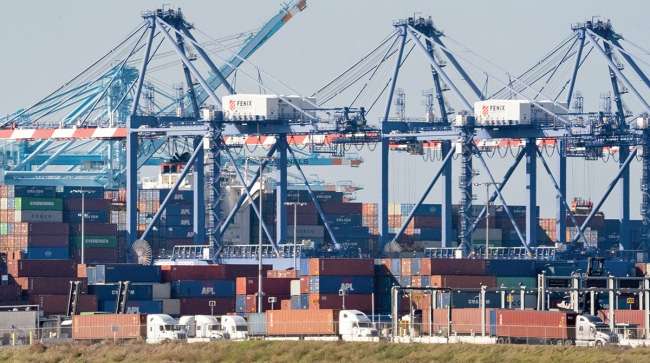Senior Reporter
Supply Chain to Remain Backed Up Until 2022, Experts Say

[Stay on top of transportation news: Get TTNews in your inbox.]
Imported cargo shipments to the U.S. are expected to remain at a record or near-record levels for several more months as consumer spending continues to restart the pandemic-damaged economy.
But economists and other experts told Transport Topics all of that buying is clogging an already overtaxed supply chain.
“I see the back half of the year remaining strong,” Port of Los Angeles Executive Director Gene Seroka said. “The peak season starts for us on Aug. 1 for our back-to-school specials, fall fashions, and then the holidays. But we have to hustle; we still have some cargo in the back lot to clean up before we pivot to peak season.”

Seroka
Seroka said the Port of Los Angeles and adjacent Port of Long Beach have improved the number of ships sitting in San Pedro Bay awaiting berths from the 60s to the high teens as of June 9.
“We continue to chip away at these ships at anchor, and they’re sitting for less time as well,” he said. “The ships are idling for about five days, and at the peak, they were sitting for eight days, so all the metrics are moving in the right direction.”
According to the National Retail Federation and the Hackett Association’s Global Port Tracker, ports they monitor moved 2.15 million 20-foot equivalent units in April, the latest month final figures are available. It marked the busiest April since NRF and Hackett began tracking container imports in 2002. The April figure was up 33.4% year-over-year, and those results followed the 2.27 million containers in March — a record for containers imported in the 19 years the program has been in place.

Hackett
“Supply chains are finding it difficult to keep up with demand as shipping capacity struggles,” Hackett Associates founder Ben Hackett said. “A number of vessels taken out of service when volumes were low remain in dry dock while others are delayed in congested ports, which face a lack of manpower both because of COVID-19 illnesses and the tight labor market.
“Many people remain hesitant about returning to work, affecting ports, rail, trucking and distribution centers.”
Rajeev Dhawan, director of the Economic Forecasting Center at Georgia State University, told TT the supply chain also is broken at the source, including key manufacturing plants around the world. That has resulted in a shortage of raw materials, including semiconductor chips, that likely will plague the system for months to come.

Dhawan
“Durable goods, even things as small as toaster ovens, have chips in them,” Dhawan said. “That has nothing to do with transportation — it has to do with production. Then you come to the supply chain after you have produced the toaster oven, Vietnam or China, and you want to send it to the U.S. There is a bottleneck at the ports with loading and unloading.”
He said the supply chain problem could be solved in a month; if manufacturers raised their prices, and then the demand for goods would drop. But because price competition is so intense, and consumers can compare prices for items on the internet before buying them, manufacturers are reluctant to raise prices too high.
“The system is working the way it’s supposed to,” Dhawan said. “Some items are on 15-day back order and it’s going to be that way until it can be delivered.”

When the pandemic started, drivers faced crowded parking lots, closed rest areas and minimal roadside support. And almost a year and a half later they still face the fear of not finding a place to park, which means having no place to rest. In this episode, host Michael Freeze seeks answers from those on the forefront of research and legislative action. Hear a snippet above, and get the full program by going to RoadSigns.TTNews.com.
Meanwhile, the Biden administration on June 8 said it wants to manufacture more critical medicines in the U.S. by expanding the use of the Defense Production Act. .That law gives the White House authority to specifically direct industrial production for national defense purposes.
The White House announcement follows the administration’s 100-day review of the supply chain after President Joe Biden signed an executive order in February investigating delays in the supply chain.
The review was tasked with studying four key sectors: semiconductor chips, pharmaceuticals, large-capacity batteries (including those used in electric trucks) and critical materials.
Global Port Tracker forecasts container volume will increase the next four months:
• June, 2.13 million TEUs, up 32.8% year-over-year.
• July, 2.19 million, up 14.2%.
• August, 2.26 million up 7.5%.
• September, 2.14 million TEUs, up 1.7%.
Volume is expected to decline 6.5% in October, to 2.07 million TEUs, marking the first year-over-year drop since July 2020.
“No one is expecting that the economy will keep on demanding products at the rate it has been demanding for the past two or three months from here to infinity,” Dhawan said. “This is a temporary problem.”
Still, the Port of Los Angeles’ Seroka said the rest of the year will be challenging.
“We’ve been buying a lot. We’ve diverted money from other sectors, so I see the balance of this year being strong,” he said. “In Q1 of 2022, as more of the economy reopens, we’ll see a more moderate flow of imports.”
Want more news? Listen to today's daily briefing below or go here for more info:




